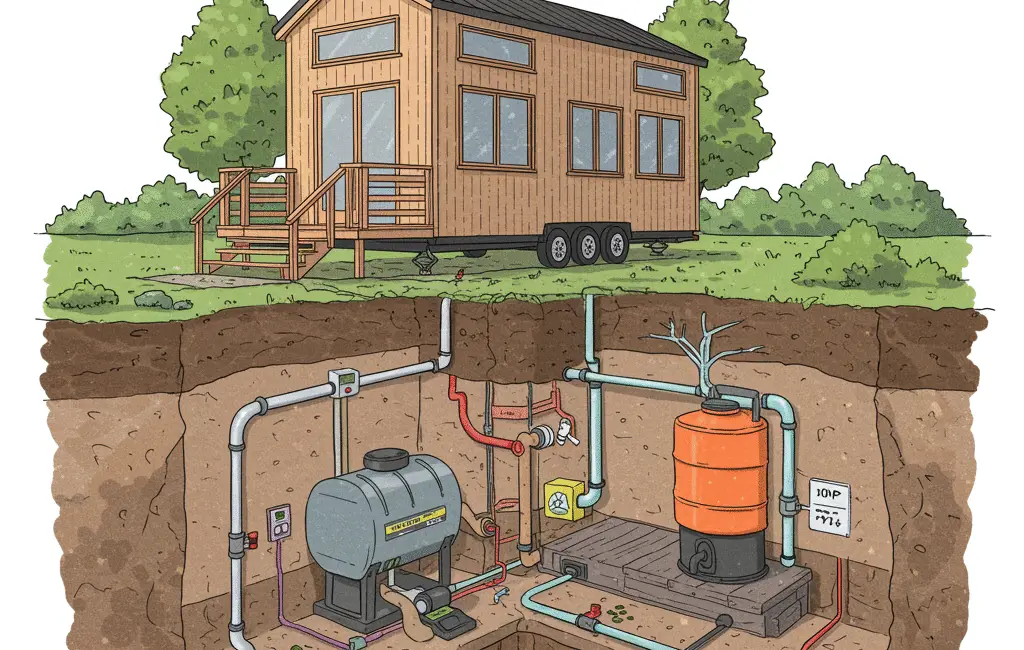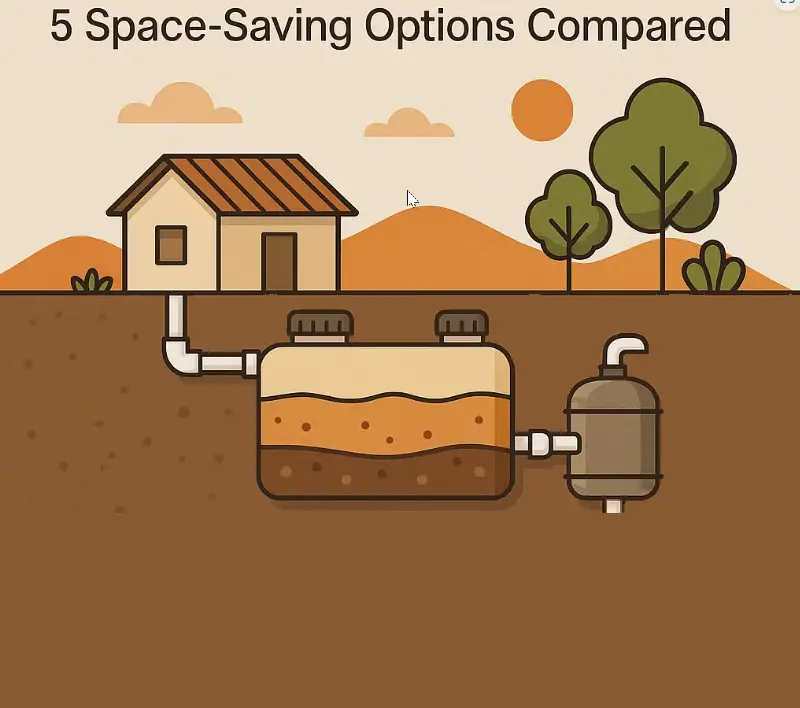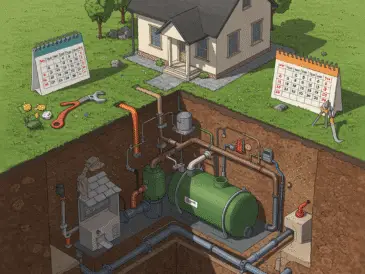The tiny home movement has exploded in recent years, with millions of Americans embracing smaller, more sustainable living spaces. But while you’re busy planning your dream 400-square-foot paradise, there’s one crucial detail that could make or break your tiny home experience: what happens when you flush the toilet.
Unlike traditional homes that can hide bulky septic systems underground, tiny homes present unique challenges that require creative solutions and careful planning.
Whether you’re going completely off-grid or parking in your backyard, understanding septic system options for tiny homes isn’t just important—it’s absolutely essential for a successful (and legally compliant) tiny living experience.
Understanding Septic Systems for Tiny Homes
When it comes to waste management, tiny homes can’t simply use a scaled-down version of a traditional septic system. The fundamental differences between standard and tiny home septic systems go far beyond size. Traditional septic systems are designed for permanent foundations, consistent water usage, and predictable waste volumes. Tiny homes, on the other hand, may be mobile, have extremely variable occupancy, and use significantly less water than conventional homes.
The most obvious difference is scale. A typical family home might generate 200-400 gallons of wastewater daily, while a tiny home might produce only 50-100 gallons. This lower volume actually creates challenges for conventional septic systems, which rely on consistent flow rates to function properly. Additionally, many tiny homes use low-flow or composting toilets, greywater systems, and water-saving appliances that alter the typical waste stream composition.
Types of Septic Systems Suitable for Tiny Homes
Conventional Gravity Systems can work for tiny homes with permanent foundations, but they’re often overkill. These systems typically require a 1,000-gallon tank minimum, regardless of actual usage. While this provides plenty of capacity, it also means higher installation costs and potentially insufficient biological activity due to low waste volumes.
Mound Systems are excellent options when soil conditions aren’t ideal for conventional systems. These raised drain fields work well for tiny homes because they can be sized appropriately for lower waste volumes. However, they require more space and higher installation costs than gravity systems.
Tankless or Composting Options represent the most innovative solutions for tiny homes. Composting toilets eliminate blackwater entirely, while greywater-only systems handle shower, sink, and laundry water. These systems can be incredibly space-efficient and environmentally friendly, though they require more hands-on management.
Key Considerations for Tiny Home Septic System Installation
Space limitations are the primary challenge when installing septic systems for tiny homes. While your living space might be compact, septic systems still require adequate clearances from wells, property lines, and foundations. A conventional drain field might need 200-600 square feet, which could exceed your entire tiny home footprint. This constraint often pushes tiny home owners toward alternative solutions or innovative system designs.
Soil testing becomes even more critical for tiny homes because you have fewer options if initial test results are unfavorable. Unlike traditional home builders who might adjust house placement based on soil conditions, tiny home placement is often predetermined by zoning restrictions, utility access, or aesthetic preferences. Professional soil percolation tests cost $500-1,500 but can save thousands in system modifications later.
“The biggest mistake tiny home owners make is assuming they can figure out septic later. Local codes vary dramatically, and what works in rural Colorado might be completely illegal in suburban California. Start with code research and soil testing before you even finalize your tiny home design.”
– Mike Rodriguez, Licensed Septic System Designer
Local codes and permitting represent perhaps the most complex aspect of tiny home septic installation. Many jurisdictions don’t have specific codes for tiny homes, leaving installers to interpret existing regulations. Some areas require minimum dwelling sizes before allowing septic systems, while others have specific rules for moveable structures. Building departments in tiny-home-friendly areas like Austin, Texas, and Portland, Oregon, have developed streamlined processes, but most areas still handle these on a case-by-case basis.
Water usage patterns in tiny homes differ significantly from traditional homes. Low-flow appliances, Navy showers, and conservation-minded residents might use 30-50% less water than code calculations assume. While this seems positive, many septic systems actually need minimum flow rates to function properly. Biological processes in septic tanks require consistent moisture and nutrient levels, which extremely low water usage can disrupt.
Installation Challenges Unique to Tiny Homes
Portability creates the most unique challenge for tiny home septic systems. Mobile tiny homes on wheels can’t use permanent septic systems, requiring either temporary connections to existing systems or completely self-contained waste management. Some owners install RV-style holding tanks for short-term stays, while others invest in portable composting toilet systems that travel with the home.
For semi-permanent installations, consider systems that can be disconnected and reconnected without major excavation. Plastic tanks are lighter and more portable than concrete alternatives, though they may require special anchoring in areas with high water tables or freeze-thaw cycles.
Seasonal usage patterns present another challenge. Many tiny homes serve as vacation cabins, guest houses, or seasonal retreats with inconsistent occupancy. Septic systems that sit unused for months can develop problems with biological processes, seal deterioration, and even structural issues from soil movement. Systems designed for seasonal use often include features like extended aeration, larger tank capacities, or simplified maintenance procedures.
Climate considerations become more important for tiny homes because the smaller waste volumes provide less thermal mass to prevent freezing. In cold climates, septic lines and tanks may need additional insulation or heating elements. Conversely, extremely hot climates can accelerate biological processes and require more frequent maintenance.
Access for service vehicles is often overlooked during initial planning but becomes critical during maintenance and pump-outs. Septic service trucks are large, heavy vehicles that need reasonably firm, level ground within 100-150 feet of the tank. Tiny homes in remote locations or on small lots may need special access arrangements or alternative service methods.
Cost and Maintenance of Tiny Home Septic Systems
Installation costs for tiny home septic systems vary dramatically based on system type and site conditions. A basic conventional system might cost $3,000-8,000, while advanced treatment units or mound systems can exceed $15,000. These costs often surprise tiny home builders who budget heavily for the structure but underestimate site development expenses.
Composting toilet systems represent the most economical option, with quality units costing $1,000-3,000 plus installation. However, these require ongoing maintenance and aren’t suitable for all users or situations. Greywater-only systems cost $2,000-5,000 and handle everything except toilet waste, making them popular for tiny homes with composting toilets.
“Don’t just look at installation costs. A $2,000 composting toilet might seem cheaper than a $6,000 septic system, but factor in your time for maintenance, local code requirements, and resale value. Sometimes spending more upfront saves money and headaches long-term.”
– Sarah Chen, Sustainable Building Consultant
Ongoing maintenance needs for tiny home septic systems often differ from traditional systems. Lower waste volumes might allow longer intervals between pump-outs, but they can also lead to incomplete biological processes or sediment buildup. Most experts recommend annual inspections for tiny home systems, even if pump-outs aren’t needed.
Composting toilets require the most hands-on maintenance, with weekly to monthly tasks depending on usage and system type. Users must monitor moisture levels, temperature, and carbon-nitrogen ratios while managing finished compost removal. While not difficult, this level of involvement isn’t suitable for everyone.
Lifecycle considerations become important for tiny homes because the structure might outlast the septic system or vice versa. Plastic septic tanks typically last 15-20 years, while concrete tanks can last 40+ years. For mobile tiny homes, shorter-lifespan systems might make more sense to reduce replacement costs during relocations.
Alternatives to Traditional Septic Systems
Composting toilets have revolutionized waste management for tiny homes, offering a completely self-contained solution that produces valuable compost instead of wastewater. Modern composting toilets bear little resemblance to the odorous outhouses of the past. Quality units like those from Nature’s Head or Sun-Mar use fans, proper carbon-nitrogen ratios, and careful moisture management to create odor-free, sanitary operation.
The main advantages include no water usage, no drain field requirements, and the ability to function completely off-grid. However, composting toilets require regular maintenance, proper ventilation, and user education. They’re also prohibited by some local codes and may impact resale value in areas where they’re uncommon.
Incinerating toilets offer another waterless option, using electricity or propane to reduce waste to sterile ash. These systems require no ongoing biological management and work well in cold climates where composting might be challenging. However, they use significant energy (1-2 kWh per cycle) and may not be suitable for off-grid homes with limited power generation.
Greywater recycling systems capture and treat water from sinks, showers, and laundry for reuse in irrigation or toilet flushing. For tiny homes, simple greywater systems can reduce septic system loads by 50-70% while providing water for gardens or landscaping. Basic greywater systems cost $500-2,000 and can often be installed as DIY projects where codes allow.
These alternatives make the most sense when traditional septic systems are prohibited, extremely expensive, or incompatible with the tiny home’s intended use. Off-grid locations, mobile homes, and areas with poor soil conditions often benefit most from alternative waste management systems.
Choosing the Right Septic Professional
Hiring licensed installers is crucial for tiny home septic systems because code compliance issues are more common and consequences more severe than with traditional homes. Many areas scrutinize tiny home installations more carefully, and any code violations could result in occupancy restrictions or forced relocations. Licensed professionals understand local requirements and can navigate permitting processes more effectively than unlicensed contractors.
When interviewing potential contractors, ask specific questions about tiny home experience. Have they installed systems for structures under 1,000 square feet? Are they familiar with low-flow calculations and alternative waste management systems? Can they provide references from recent tiny home projects? Experience with tiny homes matters because these projects often require creative solutions and thorough code knowledge.
“I always recommend getting quotes from at least three contractors, but more importantly, find someone who asks good questions about your lifestyle, usage patterns, and long-term plans. Cookie-cutter approaches rarely work for tiny homes.”
– Tom Anderson, Master Plumber and Tiny Home Specialist
Finding local experts familiar with tiny home needs often requires looking beyond traditional septic contractors. Some of the best tiny home septic installers come from RV service, sustainable building, or alternative wastewater treatment backgrounds. Online tiny home communities, local building departments, and sustainable living groups can provide valuable referrals.
Don’t automatically choose the lowest bidder. Tiny home septic installations often require more design work, creative problem-solving, and code research than traditional projects. Contractors who drastically underbid may not understand the project complexity or may cut corners during installation.
Planning for Success
Successful tiny home septic system installation requires early planning, thorough research, and realistic budgeting. Start by researching local codes and zoning requirements before finalizing your tiny home design or location. Many communities have minimum dwelling sizes, foundation requirements, or utility connection mandates that could affect your septic options.
Consider your long-term plans when selecting systems. If you might relocate your tiny home, invest in portable or easily disconnected systems. If you’re planning to stay put permanently, conventional systems might offer better long-term value despite higher initial costs. Factor in your comfort level with hands-on maintenance when choosing between traditional septic systems and alternatives like composting toilets.
Budget realistically for both installation and ongoing costs. Septic system expenses often represent 10-20% of total tiny home project costs, and this percentage increases for challenging sites or alternative systems. Don’t forget to budget for annual maintenance, periodic pump-outs, and eventual system replacement.
Frequently Asked Questions
Q: Can I use a regular septic system for my tiny home?
A: Yes, if your tiny home has a permanent foundation and meets local minimum dwelling size requirements. However, conventional systems are often oversized and more expensive than necessary for tiny homes.
Q: Do I need permits for a composting toilet?
A: Permit requirements vary by location. Some areas require plumbing permits even for composting toilets, while others have no requirements. Always check with local building departments before installation.
Q: How much water does a tiny home septic system need to function properly?
A: Most septic systems need minimum flow rates to maintain biological processes. Generally, 50-75 gallons per day is sufficient, but extremely low usage (under 30 gallons daily) can cause problems in conventional systems.
Q: Can I install a septic system myself?
A: Most areas require licensed professionals for septic system installation due to health and safety concerns. However, some simple greywater systems or composting toilets may be suitable for DIY installation where codes allow.
Q: What happens if my tiny home septic system fails inspection?
A: Failed inspections can result in occupancy restrictions, fines, or requirements to modify or replace the system. This is why hiring experienced, licensed professionals is crucial for tiny home installations.
The key to successful tiny home septic system installation lies in understanding that smaller doesn’t always mean simpler. While your living space might be compact, waste management still requires careful planning, proper installation, and ongoing maintenance. Whether you choose a traditional septic system, composting toilet, or innovative greywater recycling setup, the most important step is starting your research early and working with professionals who understand the unique challenges of tiny home living. With proper planning and the right system for your needs, you can enjoy all the benefits of tiny home living without compromising on comfort, legality, or environmental responsibility.




